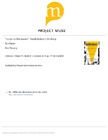| dc.description.abstract | “New York Time,” previously “The Hudson Letter” (1996), opens in “Winter,” and the poetic speaker is awoken amid snow and ice in New York City to the combined but competing strains of “the first bird and the first garbage truck.” These “garbage trucks,” which will later discharge their discarded cargoes onto the “refuse barges” (NCP, 167) of the fourth section, “Waterfront,” of the sequence, are twinned with the early-morning avian chorus outside the beleaguered speaker’s apartment window. The discordant sonority of the metropolis’s daybreak exposes the tonal ambiguity of the longer poetic sequence at the same time as it addresses, in cursory fashion, the dynamics of the human and nonhuman ecological crisis. Derek Mahon initiates his sequence, and this day, with an incongruous but all too frequent urban duet, which aggregates the natural and the fabricated, and the sentient and the inanimate, all of which are “a measure of his response to the crisis of industrial (or postindustrial) modernity, with useless rubbish, garbage, or waste functioning as a secular memento mori of the empire of the transient that is consumer culture.” In a concise ironic gesture, Mahon disallows the muse-like possibilities of the unseen birdsong by using the mechanical, utilitarian functions of the disposal vehicle. Not only does this reference, among many others across “New York Time,” partake of a preoccupation with waste, but it neatly holds in one line a matter of urgency within contemporary environmentalist criticism: the uneven, competing claims of the environment and of global capital. | en_US |


